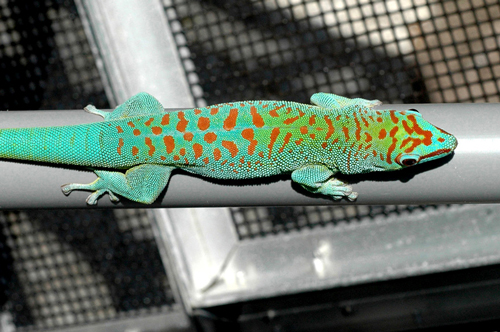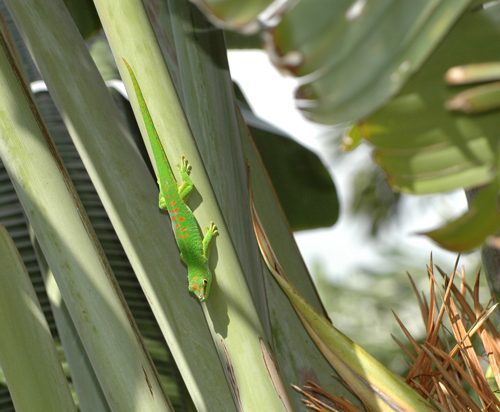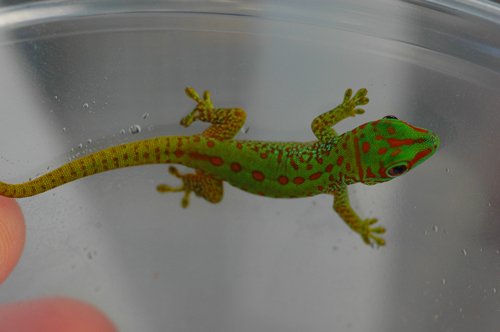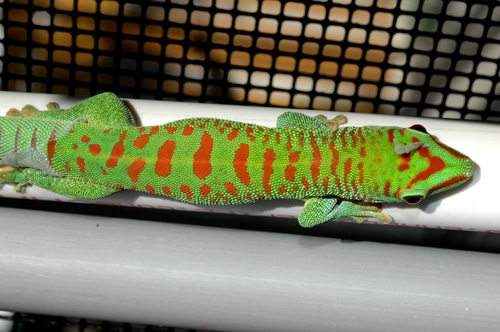Care sheet for the giant day gecko (Phelsuma grandis).
Giant Day Gecko (Phelsuma grandis)
Giant day geckos have become very popular in the reptile trade. Even mainstream advertisers have picked up on the likability of the species, hence the now-famous Geico Gecko, thought to be modeled after a day gecko.
Due to its extraordinarily vibrant colors and ideal size for a home terrarium, the giant day gecko (Phelsuma grandis) has captivated reptile enthusiasts. Select breeders have produced what are arguably the most beautiful lizards in the world, the crimson (see photo) and blue blood day gecko (see photo). They are forms of living art, and people who own them usually display them as a decorative focal point in a room or an outside garden.
Giant day geckos are widely distributed in northern Madagascar, including some of the offshore islets. Because giant day geckos are followers of civilization, they are found in gardens, huts and tree plantations in this area. This is the tropical rain forest region which is characterized by hot and humid weather.

Jon Klarsfeld
Blue blood giant day gecko.
Giant Day Gecko Availability
Until the mid 1980s, giant day geckos were rare in reptile collections and considered a highly prized captive. They can now be found in local pet stores, with online breeders and at reptile expos. Prices vary depending on age and color quality but range from $45 to $250. A new or rare color morph can cost considerably more. Wild-caught giant day geckos (see photo) are still sporadically imported from Madagascar. These animals are certainly beautiful but are rarely as healthy or as colorful as their captive-bred counterparts. Environmentally conscious reptilekeepers should insist on purchasing only captive-bred specimens. Supporting the continued depletion of Madagascar’s fauna needs to be discouraged due the island nation’s critical environmental status.
Giant Day Gecko Size
As its name implies, the giant day gecko is the largest member of the day gecko group. Adult males can reach a foot in total length. Females are typically 1 or 2 inches smaller. They are a well-muscled and thick-bodied gecko.
Giant Day Gecko Life Span
If cared for properly, giant day geckos can live for a long time. Records of them surviving for 20 years exist, but the average lifespan is between 6 to 8 years.

Jon Klarsfeld
Wild normal giant day gecko.
Giant Day Gecko Caging
Giant day geckos do best when housed individually or in pairs. Males cannot be housed together, because they will fight excessively until the subordinate male is severely injured or killed. At times, pairs will reject each other’s company and fight. When this occurs, they will have to be separated. Some male/female pairs will bond for life and never fight. These individuals should not be separated, because they may not accept another mate.
Giant day geckos thrive in well-planted naturalistic terrariums. Because giant day geckos are arboreal, the enclosure should be vertically oriented. Screen and glass enclosures measuring 24 inches tall by 24 inches long by 12 inches wide will comfortably house an adult pair. Bamboo has been a long-time favorite cage furnishing, as it is ideal for climbing, basking and egg laying. Live plants will add to the naturalistic design and increase enclosure humidity.
Although not essential, exposing giant day geckos to natural light has positive health benefits. If you live in an area with favorable conditions, housing geckos outside is encouraged. Remember: They always need to have access to some shade to cool off. Make sure you are very careful if you do this as to not release exotic animals into the wild.
Giant Day Gecko Lighting and Temperature
Giant day geckos are diurnal. The use of a high quality UVB light will help to fill the gecko’s vitamin D3 requirement. An incandescent light bulb of the appropriate wattage should be used to maintain a 95 degrees Fahrenheit basking spot. The ambient temperature should range from 82 to 86 degrees during the day and 75 to 82 degrees at night. Captive giant day geckos will use this thermal gradient to thermoregulate to their optimal body temperature.

Jon Klarsfeld
New morph hatchling giant day gecko.
Giant Day Gecko Substrate
Many substrates designed for rain forest terrariums can be used successfully, including peat/soil mixtures, coconut fiber and various bark chips. The only provision is that the particle size of the substrate should be large enough so that it cannot be accidentally ingested by the geckos while they are catching insect prey, as this could lead to intestinal blockage.
Giant Day Gecko Food
Giant day geckos are highly opportunistic feeders. In the wild, they consume various insects, fruit, small lizards and even small mammals if given the opportunity. This diverse palate makes feeding giant day geckos in captivity simple. They accept commercially bred insects such as crickets, waxworms, mealworms and cockroaches. Commercially available nutritionally balanced diets for frugivore lizards have become available (e.g., Repashy Superfoods) and are highly recommended for giant day geckos. Insects can be offered two times a week and fruit diet one to two times a week.
All insect prey should be dusted with a high-quality calcium/vitamin D3 supplement at every feeding. A multimineral supplement should also be used once per week. These supplements can be added to fruit-based diets as well.
Giant Day Gecko Water
Daily misting of the enclosure provides giant day geckos with their water requirement. They will lick water droplets from enclosure decorations. If misted directly, their tongues will remove water from their eyes and nose. Daily misting also acts to maintain the enclosure’s desired ambient humidity of 50 to 70 percent.
Giant Day Gecko Handling and Temperament
Giant day geckos are mainly a terrarium species to be enjoyed within their enclosures. Nevertheless, they will get to know their caretaker and, with time, will take a cricket or fruit diet from their keeper’s hand. Some even tolerate brief periods of handling, but one should never grab a giant day gecko, as the skin could slough.
Giant Day Gecko Health
Giant day geckos appear to be less susceptible to disease than other reptiles are. This is probably due to multiple variables but includes inherent disease resistance and strong immune function.
Giant Day Gecko Breeding
Many people who purchase giant day geckos intend to breed them. If maintained under the above parameters, they will breed and lay eggs on a regular basis. Captive maintenance of neonates is identical to that of adults except that enclosures should be considerably smaller and food items sized appropriately. Plastic containers measuring 12 inches by 12 inches by 12 inches are adequate to house one or two hatchlings, and 2-week-old crickets are a readily accepted meal after the neonate’s first shed.
The giant day gecko is emerging as a staple in reptile collections, and with its continued selective breeding, you can expect even further improvements in terms of color, tameness and disease resistance.
Jonathan D. Klarsfeld, DVM is the source for Giant Day Gecko information and breeding. Please visit his site at GiantDayGecko.com.



